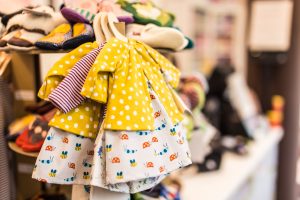
From low-priced onesies costing a couple of dollars to high-end ruffled dresses costing a couple of hundred dollars, baby apparel is the topic of this week’s post. Today’s market size shows global baby apparel revenues in 2018 and projected for 2025. Baby apparel refers to clothing for babies and toddlers 0 to 36 months old.
In 2018, most of the clothing bought, more than 65%, was outerwear. When buying clothing parents look for convenience, comfort, and safety. Parents want clothing that can easily be put on a squirming child and clothing that will be easy to remove for diaper changes. They also want their child to be comfortable wearing the clothes, and they want their child to be safe in them. Most clothing made for babies worldwide is made of synthetic material with dyes that can cause skin irritation and rashes. This is especially a concern with underwear. As a result, parents are expected to increase spending on undergarments that are made from natural fiber and have antibacterial and antiviral protection. Flame retardancy is also a concern. While the United States has strict regulations, other countries may not, but more governments are expected to regulate their textile industries in the next few years and create policies to make baby apparel safer.
In addition to relying on regulations for safety, if there are any in the countries in which they live, parents are choosing clothing without drawstrings or adornments such as buttons and fancy laces that could be torn off or rip causing a child to trip or leading to a choking or strangling hazard. At the same time, new parents want stylish, durable clothing. Increasingly, fashion shows and exhibitions promoting baby apparel are being held around the world to showcase fashionable clothing lines. Some of these venues also launch new clothing lines for infants, toddlers, and children. Social media sites such as Facebook, Instagram, and Pinterest that allow parents to easily keep up with fashion trends are also influencing parents’ buying decisions.
Discounts offered on e-commerce sites such as Flipkart, Amazon, and Alibaba are increasing online shopping for baby clothes; however, in 2018, online revenues were a mere fraction of the revenues from offline channels. Sales at brick-and-mortar retail establishments comprised more than 75% of total global revenues. That being said, online sales are expected to increase faster than offline sales, at a compound annual growth rate of 6.1%, from 2019 to 2025. Carter’s, Inc.; Cotton On Group; Hennes & Mauritz AB; Gerber Childrenswear LLC; and Naartjie have been focusing on increasing their presence in brick-and-mortar stores to meet demand. In 2018, Carter’s Inc. had more than 1,000 stores in North America and more than 17,000 wholesalers. Other major manufacturers include Nike, Inc.; Gymboree Group, Inc.; and Industria de Diseño Textil, S.A.
Geographic reference: WorldYear: 2018 and 2025
Market size: $135.5 billion and $198.8 billion, respectively
Sources: “Baby Apparel Market Size, Share & Trends Analysis Report by Product (Outerwear, Underwear), by Distribution Channel (Offline, Online), by Region, and Segment Forecasts, 2019 – 2025, Grand View Research Report Summary, September 2019 available online here; “Baby Apparel Market Size Worth $198.8 Billion by 2025 | CAGR: 5.6%,” Grand View Research Press Release, September 2019 available online here; “Baby Clothing Market in the US 2015-2019,” Technavio Snapshot, April 2015 available online here; “Introduction to Japanese Underwear Designed While Putting the Safety of Babies First,” Pregnancy, Childbirth, Miki House, June 23, 2017 available online here.
Image source: Baby Natur, “Assorted-color Long-sleeved Dresses Photo,” Unsplash, June 14, 2019 available online here.
